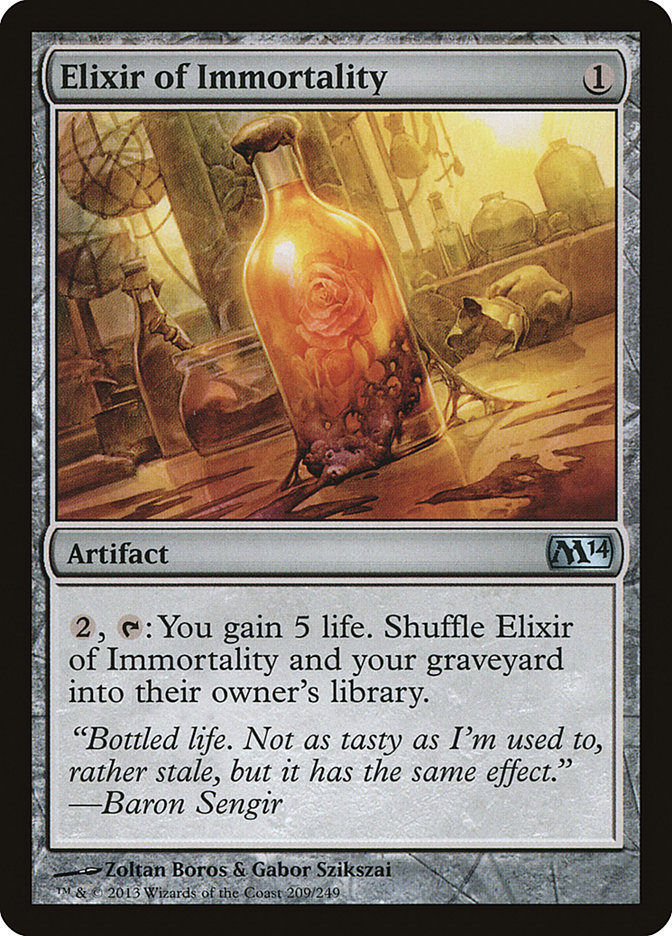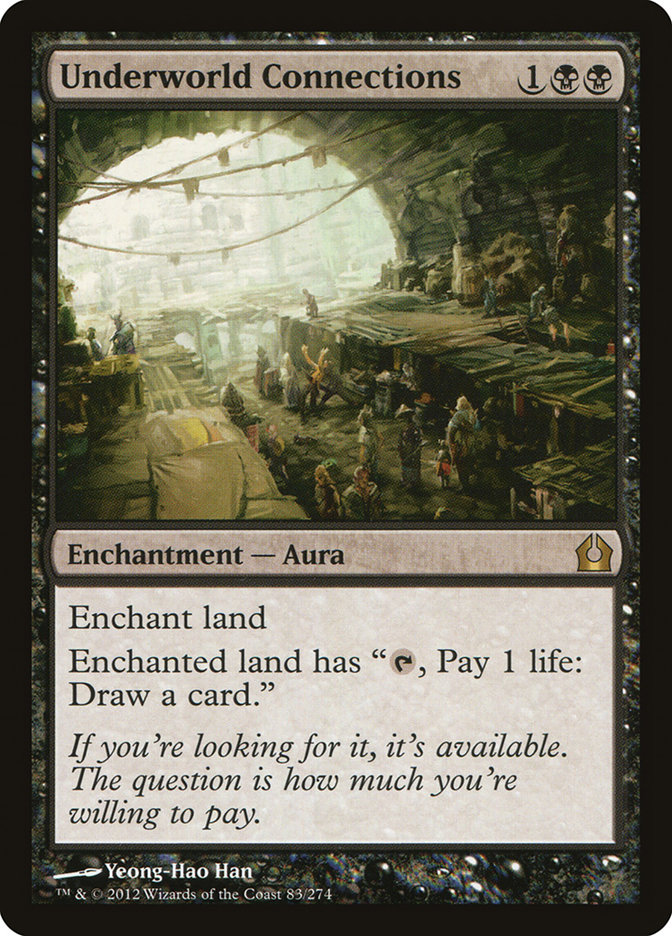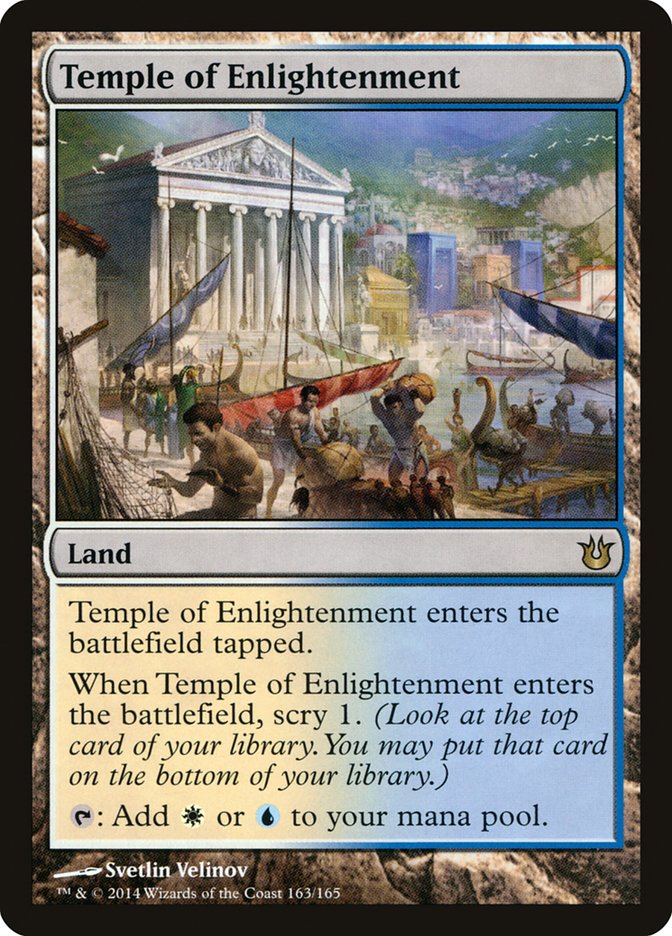There are few things as omnipresent in Magic’s history as U/W Control.
Red Aggro, White Weenie, and U/W Control have existed in nearly all moments of the game (with the notable exception of some Block Constructed formats). This is all a result of the choices that Wizards of the Coast has made with regards to the color wheel primarily. Cheap white creatures have been a mainstay in Magic. Burn and cheap creatures have as well. And a suite of creature removal, permanent handling, and countermagic have too. It’s only natural really.
For a lot of other archetypes, the things that make the deck tick just aren’t there. It’s hard to find a moment in history where these three decks aren’t in play in the major tournament format of the moment.
The Past
While it wasn’t literally the first U/W Control deck, Brian Weissman’s "The Deck" was the Platonic Ideal of the U/W Control deck. Even looking at it today, knowing what it was competing against, gives me shivers:
Creatures (2)
Lands (14)
Spells (44)
- 4 Mana Drain
- 2 Counterspell
- 3 Plains
- 4 Swords to Plowshares
- 1 Sol Ring
- 1 Regrowth
- 1 Mind Twist
- 1 Demonic Tutor
- 1 Braingeyser
- 4 Island
- 1 Time Walk
- 1 Ancestral Recall
- 2 Red Elemental Blast
- 1 Jayemdae Tome
- 2 Disrupting Scepter
- 4 Disenchant
- 1 Recall
- 2 Moat
- 1 Mirror Universe
- 1 Timetwister
- 1 Black Lotus
- 1 Mox Emerald
- 1 Mox Jet
- 1 Mox Pearl
- 1 Mox Ruby
- 1 Mox Sapphire

This deck was only barely concerned about winning. It was mostly just concerned with one thing: card advantage and living. By slowing knitting up all of the ways that your opponent might escape, you could kill them any old time with whatever.
I remember Dan Bock calling this "Scryb Sprite Recursion" back in 1997.
The idea of "Scryb Sprite Recursion" was just that the kill didn’t even really matter. You’d kill them via something, and it could be something as absurd as just recurring Scryb Sprites back into your deck. (Amusingly, when Bitterblossom was printed, we all got a sense of what aggressively recurring Scryb Sprites could look like.)
Mike Flores talked about how this deck (“The Deck”) gave us the vocabulary to understand what the hells was happening. “Card advantage” was a new idea, but we started to realize something that seems obvious now: two cards are better than one. This is something that is obvious to most Magic players, but you begin to realize how it is only obvious by virtue of our experience once you play a game like Ascension and you notice that your opponent doesn’t seem to care about the card that says, “Draw two cards.”
Answers, answers, answers. If you just answered one card for one card, you’d fall behind. Add in card advantage and you can overwhelm the opponent. This idea distilled down to its essence is old enough to vote now. Eighteen years. When the hell did that happen?
We don’t really see decks just continue to grow in Magic though. They shift for the times. Vintage, the inheritor to Type 1, doesn’t really have a deck that we could easily compare to The Deck. But in Standard we certainly have such a deck.
The Present
If you have been under a rock for the last week, you may have missed the results of the most recent Standard Grand Prix.
Grand Prix Vancouver Top 8
U/W Control: 1st, 3rd, 8th
Mono-Blue Devotion: 2nd, 6th, 7th
Mono-Black Devotion: 4th, 5th
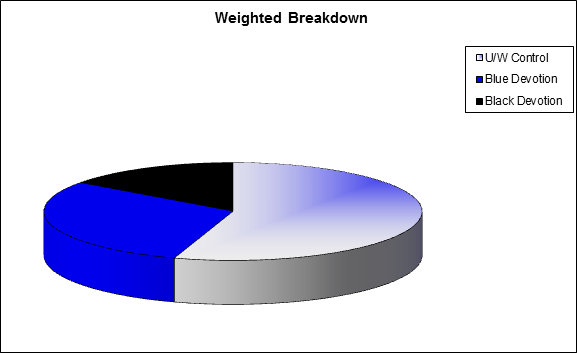
Over 1,000 players clashed, and it ended with a very decisive finish for the eventual champion, Alexander Hayne, who lost zero games in the Top 8.
Here is his list:
Creatures (1)
Planeswalkers (7)
Lands (17)
Spells (35)
- 5 Plains
- 5 Island
- 4 Last Breath
- 3 Syncopate
- 2 Azorius Charm
- 4 Supreme Verdict
- 4 Detention Sphere
- 4 Sphinx's Revelation
- 4 Dissolve
Sideboard

For the sake of comparison, let’s also look at Robert Gillespie’s and Mike Vasovski’s lists so we can see how much variance they have in the maindeck.
Gillespie (3rd):
+1 Island
+1 Plains
-2 Temple (4 assorted Temple instead of 6)
-1 Aetherling
-1 Last Breath
-1 Azorius Charm
-1 Dissolve
-2 Syncopate
-1 Elspeth, Sun’s Champion
+1 Elixir of Immortality
+2 Divination
+2 Essence Scatter
+1 Disperse (go, Disperse!)
While this initially might look like a lot of differences, so much of this is just a nudge in one direction or another. The major substantive difference is that Gillespie is an Elixir deck and takes advantage of that with more card draw and a more diverse sideboard.
Vasovski:
+1 Island
+1 Plains
-3 Temple (3 instead of 6)
-1 Mutavault
-2 Last Breath
-2 Syncopate
-1 Jace, Architect of Thought
-1 Aetherling
+1 Elixir of Immortality
+2 Quicken
+3 Divination
Vasovski is not only an Elixir deck but also a shaves off some lands for Quicken and yet more card draw. His list is actually fairly close to William Jensen’s second-place list from Grand Prix Dallas-Fort Worth in December:
Planeswalkers (4)
Lands (26)
Spells (30)
- 2 Syncopate
- 2 Quicken
- 4 Divination
- 1 Elixir of Immortality
- 1 Ratchet Bomb
- 4 Azorius Charm
- 4 Supreme Verdict
- 4 Detention Sphere
- 4 Sphinx's Revelation
- 4 Dissolve
Sideboard

In its current incarnation, this deck clearly isn’t exactly new to Standard. What is new though is its seeming ubiquitousness in the metagame. In my opinion that is because of the following situation in the metagame:
- The power of Mono-Black and Mono-Blue Devotion largely pushes other decks, particularly aggressive decks, out of the metagame.
- Esper Control decks have had in the past to deal with more aggressive metagames, and control players have largely shifted into U/W.
- There have not been enough U/W Control players in the metagame to be preyed upon by Esper.
Another reason that the deck has risen to prominence though is the success of the Mono-Black Devotion deck period. While a lot of players feel like Mono-Black has all of the tools it needs to fight against a control deck, the more I’ve played it, the more I feel like the matchup is largely a cakewalk.
Take for example my match playing U/W Control versus Mono-Black Devotion at a recent PTQ. My opponent drew eighteen extra cards in game 1 with Underworld Connections and fifteen extra cards in game 2. It just didn’t matter. The answers and card advantage I was packing were too much for him. I ended up being his only loss in the Swiss, and he made his first Top 8 with Mono-Black Devotion. But basically he couldn’t keep up against me.
A part of this is the inclusion of this little card:
One of the reasons that Elixir is so powerful in this matchup is that you simply never run out of card advantage. And in this matchup your card advantage is just so much better than their card advantage. Take the backbone of the deck’s card advantage, at least in game 1:
It’s very well worth noting that Owen Turtenwald, a great player who has piloted this very deck to great success, has called Underworld Connections "bad." Even recently he’ said that he hates the card in the deck. A big part of the reason is just how slow the card is. It’s practically a five-mana bad Read the Bones (three mana for the casting, two "mana" for the two activations), and it takes forever to actually get value out of. You can recoup the losses certainly via their application in helping devotion and in the way they can fuel a Pack Rat. Unfortunately for Mono-Black, U/W Control can just have access to so much more card advantage, so that unless they are on the ropes U/W can just slowly push them over.
My own version of the deck isn’t very different than the other Elixir builds either, at least in the main. I do push the value of Elixir with a few more semi-analog singletons and more card draw, but this is the best way to build an Elixir style deck. If you aren’t going to try to overpower your opponent with one go through (what you see in Alexander Hayne’s list), the alternative lets you gain value from the marginal differences in cards, with the expectation that you’re playing for a game that is more likely to go to a very long end.
In that high reward cards can have nice value, but also importantly when they have a low return, it isn’t as big of a deal because you’re more able to replace them. If you’ve played the current Standard enough, you realize that the U/W Control decks actually have so much card advantage that you end up turning some of your Jayemdae Tomes into Jalum Tomes (which is just an old man’s way of saying you discard excess cards because you have so much card advantage).
Here is that build:
Creatures (1)
Planeswalkers (5)
Lands (14)
Spells (40)

Since I posted this list, I’ve had a small handful of people tell me they made Top 8 of an event with it. I can’t know for sure, but I wonder if Robert Gillespie’s build took some ideas from mine. Whatever the case may be, these decks are all so similar that they really are only gentle nudges away from each other.
I wish that the PTQ season that was underway wasn’t shifting so soon. Despite the fact that I love new sets, if I could I’d just keep plugging away with this list because of how smoothly it has been playing out for me against all comers.
Earlier in the season before Mono-Black Devotion had really settled into its current Ratty groove (it still was usually only running two Rats) and when Esper was all the rage, I was crushing people with the R/W Aggro deck that I helped Adam Jansen and Ronny Serio test. The metagame was ripe for an aggressive deck like that, and the control decks just weren’t prepared for it. I finished in the Top 4 of an SCG Standard Open and won a 5K with the deck before finally being put off of it by the appearance of U/W Control, a control deck that could actually do what it needed to suppress R/W Aggro.
It made me jump ship and shift my focus to my own U/W Control deck. After doing so, I remain convinced (despite everything Sam Black has said) that it is the best archetype in Standard.
But metagames don’t stand still. Particularly when a new set arrives.
The Future
You might look at the new set and think that it is low impact enough to mean that U/W Control is going to remain if not the king of the hill at least one of the archetypes vying for the spot. The general opinion on this set so far seems to be that it has very few heavy hitters for Standard, so we shouldn’t expect to see much changing, right?
I would definitely say . . .
WRONG.
The first thing to look at is those three premises I brought up about why U/W Control has been thriving. One of the big parts of why is that it hasn’t had a target on its head. Right now, though, it absolutely has a huge target on its head. This is going to mean that it makes a lot more sense for a Mono-Black Devotion deck to have access to a full set of eight discard and three Erebos in its full 75 cards. By the same token, it also means that it’s more reasonable for Mono-Blue Devotion to have more aggressively anti-U/W sideboard plans in place. For the most part, both of these archetypes were certainly respecting the existence of U/W Control, but they weren’t aiming for it right between the eyes.
That is going to change.
Every deck struggles a bit more when there are targets painted on it. Even the most powerful decks do as long as the tools exist to fight them. One of the most obnoxious of these moments was US Nationals 2009, when 31 Volcanic Fallouts and 32 Great Sable Stags showed up in the Top 8 of that event, basically running Faeries out of town. I still remember being paired against Gerry Thompson at the 0-3 table, our Cryptic Commands feeling pretty horrible thus far in the tournament, battling it out to not be the 0-4 player. (He got me. Damnit.)
U/W Control definitely has cards that can hurt it. Boros Charm. Voice of Resurgence. Obzedat, Ghost Council. From Born of the Gods, Spirit of the Labyrinth. Expect to see all of these being played.
In addition, if U/W Control is one of the best decks, it’s harder to argue against Esper as a great choice. While it isn’t exactly true for Esper that "anything you can do/I can do better/I can do anything better than YOU," it practically is the case when Esper faces off against U/W Control. The only thing that U/W Control gets to have as an advantage in that matchup is Mutavault. Literally anything else Esper could reasonably choose to play as well. In that kind of matchup, Duress, Thoughtseize, and Sin Collector are all quite dangerous for U/W Control.
So all of these things are bad for U/W Control, sure. But is there any silver lining?
Well, it still is a low-impact set, so a lot of archetypes aren’t going to shift all that much in their respective power levels. This bodes well for such a powerful deck. In addition, one of the most potent cards for U/W Control will finally be available to it:
One of the big questions that is going to emerge for U/W Control is "exactly what should my mana look like?" A ton of players have been playing as many as six Temples on top of Azorius Guildgates. I’ve been running three. Once the U/W deck has its own Temple, what is the correct mana base?
I still haven’t figured it out, but I tend to believe mana is best worked out by brute force trial and error. Empirical testing will sort this out, but there are truly a ton of options. I remain wary of too many comes-into-play-tapped lands, but I know I’ll be starting with Temple of Enlightenment. I just wonder if my Azorius Guildgates will be getting shaved down or my off-color Temples.
I’ve had a lot of brainstorming sessions about what I might be adding to my 75. The list of cards is incredibly short:
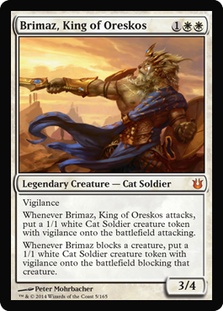
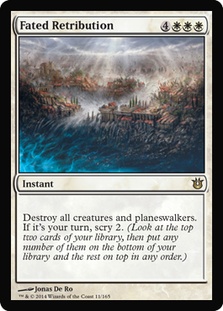
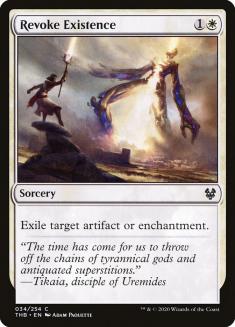
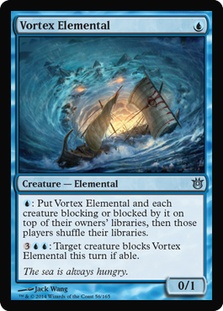
Of these Brimaz strikes me as the one that might end up being a real game changer, but I don’t know if I like the card when it comes to how it matches up in the U/W Control mirror, though Brian Kowal was trying to tell me it would be potentially very powerful.
I still think that U/W Control is very powerful, but I do think it’s going to slip down to a fourth- or even fifth-best deck after Born of the Gods comes out. I don’t know that it gains very much to change its fate, and it’s going to have a lot of decks gunning for it. Importantly Esper (and even simply U/B Control) look to have gained a lot of weapons in Born of the Gods, and it just might not make much sense to stick with two colors any longer. Of course, soon enough SCG Standard Open: Nashville will be here, and we’ll begin to see how things will shake out.
This weekend is the Prerelease of Born of the Gods. Usually I tend to take whatever red faction is most to my fancy. This time around I expect to take the white one, if only for the extra chance at some cards for my U/W Control deck. What about you?
Until next week,

